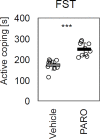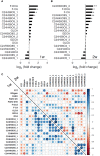Paroxetine Administration Affects Microbiota and Bile Acid Levels in Mice
- PMID: 32581888
- PMCID: PMC7287167
- DOI: 10.3389/fpsyt.2020.00518
Paroxetine Administration Affects Microbiota and Bile Acid Levels in Mice
Abstract
Recent interest in the role of microbiota in health and disease has implicated gut microbiota dysbiosis in psychiatric disorders including major depressive disorder. Several antidepressant drugs that belong to the class of selective serotonin reuptake inhibitors have been found to display antimicrobial activities. In fact, one of the first antidepressants discovered serendipitously in the 1950s, the monoamine-oxidase inhibitor Iproniazid, was a drug used for the treatment of tuberculosis. In the current study we chronically treated DBA/2J mice for 2 weeks with paroxetine, a selective serotonin reuptake inhibitor, and collected fecal pellets as a proxy for the gut microbiota from the animals after 7 and 14 days. Behavioral testing with the forced swim test revealed significant differences between paroxetine- and vehicle-treated mice. Untargeted mass spectrometry and 16S rRNA profiling of fecal pellet extracts showed several primary and secondary bile acid level, and microbiota alpha diversity differences, respectively between paroxetine- and vehicle-treated mice, suggesting that microbiota functions are altered by the drug. In addition to their lipid absorbing activities bile acids have important signaling activities and have been associated with gastrointestinal diseases and colorectal cancer. Antidepressant drugs like paroxetine should therefore be used with caution to prevent undesirable side effects.
Keywords: antidepressant; bile acids; metabolomics; microbiome; paroxetine.
Copyright © 2020 Dethloff, Vargas, Elijah, Quinn, Park, Herzog, Müller, Gentry, Knight, Gonzalez, Dorrestein and Turck.
Figures




